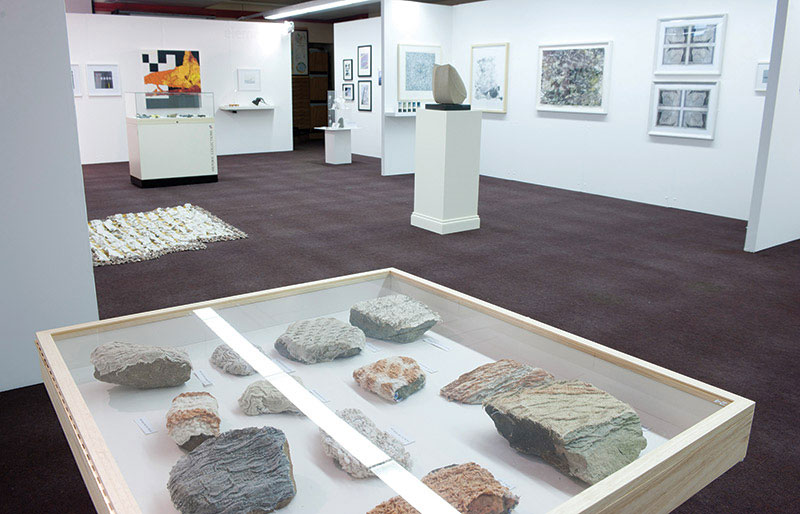The fifth annual Fabric of the Land art and science exhibit is proving valuable to geologists - and artists around the world.

The popular Fabric of the Land, an exhibit that blends art and geology, celebrates its fifth anniversary this month at the University of Aberdeen in Scotland. Photo courtesy of Fabric of the Land.
When last we left Fabric of the Land in 2009, an exhibit held at the University of Aberdeen in Scotland that explores the interconnectivity between art and science – particularly geology – it was a modest show set in the digs of the school’s geology department.
Its purpose then was to bring together local artists and scientists, showcase their work in an attempt to capture the rich geologic setting of the area.
It still does.
It’s just not so modest anymore.
The show, now in its fifth year, was designed to bridge the divide between the two disciplines, according to school professor and AAPG member Andrew Hurst, who founded and organizes the event.
Those disciplines often looked at each other with amusement and skepticism, Hurst noted.
But Hurst, professor and chair of production geoscience at the University of Aberdeen, also always believed that artists and scientists had more similarities than differences. And it seemed like a good idea to test the theory.
He turned out to be right.
The primary aim of FOTL, aside from linking the artistic and scientific communities of Aberdeen, was to encourage those to explore and create lasting images of the Scottish environment and landscape and to show how it is shaped by the geology of the place – to show, in a sense, the fabric of the land.
“Through Fabric of the Land we seek to bring public attention to art and science and the areas of common inspiration,” Hurst said earlier this year.
And for this show, like the first four, artists again were encouraged to create works that derive from, or are inspired by, that link; scientists were urged, as well, to explain, to illustrate, to mold that art, to put it in perspective.
They both succeeded – often simultaneously.
Gifts to Share
This year’s show will be presented Aug. 24-Sept. 13, and will feature more of the works submitted throughout the year.
It is an open admissions policy. Cash prizes are awarded for the top three entries. The only criteria: quality.
The work is viewed by a high profile selection panel from all backgrounds that participate in selecting the top exhibits – this year, around 60. In addition, a distinctive subsidiary theme is selected for each exhibition, bringing a wealth of even more creativity to the region.
“I think the main reason for the show’s success,” Hurst says, “is its unique offering. It’s outreach in every possible sense of the word. Art and science uses each as facilitators. At its basic level, it’s about mutuality.”
What surprised Hurst at first (and you sense it still does) was what spurred artists to create.
“When we started, I thought the show would be a great opportunity for artists to sell their work, to help them do that,” he said. “What I have learned, though, is not only do they like to sell the pieces – obviously – but they also want these works to be seen. To share them. To get them noticed.”
Susana Braz, group external affairs manager for Dana Petroleum, the company now underwriting FOTL, echoes Hurst’s beliefs and explains why her company is involved.
“Our perspective when we first got involved was that it was a very interesting event from University of Aberdeen – bringing art and science and community into the university,” she said.
Bringing these groups together brought them closer to each other’s world, too, which she says, for some, was just a reminder for some of them.
“Many scientists started out as artists.”
As the show grew, space became tighter (Hurst said a limit had to be placed on not only the number of exhibits featured, but also their size.)
Luckily, when the department’s offices are renovated, so, too, will the space used for FOTL.
The show also will start to travel.
First stop: Edinburgh, home of the Scottish Parliament.
Braz says the proximity of the show will make it easier for government officials to see the exhibition, see its importance and, with any luck, help promote and fund it accordingly. As it stands now, the FOTL has already secured at least one grant from government institutions that matches Dana’s funding.
“This has a potential to grow,” she says.
That growth, both Braz and Hurst say, will one day bring FOTL to other schools and facilities within the country.
“It can be much bigger,” Braz adds.
Hurst says costs probably prohibit taking the show much past Scotland, despite their aspirations; touring it through Europe would be difficult, through America impossible.
But he says the show could be recreated in university communities in the United States – similar to Aberdeen, which he calls a “vibrant” setting – where a similar arrangement between artists and scientists could be explored. He has been in early talks with some American colleagues about such a venture.
Hurst passionately believes there is something wonderful about the connection between art and science. He himself is a scientist, yes, an administrator, yes (though he likes this part of his world least of all) but when he looks forward to retirement, he looks forward to doing something else, something he’s always loved.
“I want to write. I am a writer,” says this scientist.
“Both sides,” he says of science and art, “help each other.”
And he’s looking forward to seeing if that’s true.